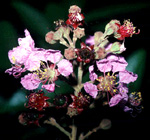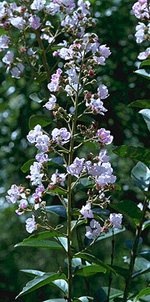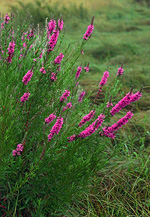 |
This is a small, mostly pantropical family, although with a few characteristically temperate genera in both Hemispheres. In Australia, members for the family may be herbs or subshrubs found in wet, marshy places in the tropics or temperate regions, or woody plants mostly found in vine thickets and drier rain forests in northern Australia.
Characteristic features of the family Lythraceae in Australia include: - perennial herbs to small trees
- leaves opposite or whorled
- flowers with a prominent hypanthium-tube, actinomorphic; petals crumpled and crepe-like in bud
- ovary of 2-6 fused carpels, superior, maturing to a many-seeded capsule
Description
Evergreen trees, or shrubs, or annual or perennial terrestrial herbs, or aquatic herbs rooted in the substrate with their leaves submerged or emergent. Perennating by rhizomes. Vegetative reproduction absent or by rhizomes or stolons. Internal secretions not obvious. Plants glabrous, or with simple, glandular or non-glandular, unicellular or uniseriate hairs. Leaves alternate and spiral, opposite, or in whorls of 3–7 or more, cauline if herbs, petiolate, subsessile or sessile. Stipules present or absent. Lamina simple, symmetric, filiform, acicular, subulate, linear, lanceolate, ovate, elliptic, oblanceolate, ovate, oblong or orbicular; base cuneate, attenuate, rounded or cordate; margins entire, ±flat; one-veined, or the venation pinnate, with the midrib conspicuous or inconspicuous, and the tertiary venation not reticulate; surfaces not punctate; herbaceous, leathery or succulent. All the flowers bisexual. Inflorescences terminal or axillary, consisting of glomerules, racemes, umbels, panicles, dichasial cymes or solitary flowers. Bracts present. Bracteoles present or absent. Mucilaginous hairs present within the bracteoles. Flowers odourless or fragrant; sessile or stalked. Floral disc present; nectaries present on the disc. Free hypanthium present. Perianth regular, of 2 dissimilar whorls, or of 1 whorl only, or all whorls ±similar. Calyx segments free, or apparently fused, with 3–7 sepals or lobes, valvate in bud; calyx bell-shaped; herbaceous or rarely membranous. Corolla segments free, with 0–7 petals, alternating with the sepals or calyx lobes, crumpled or plicate in bud, white, yellow, orange, pink, magenta, purple or violet, without contrasting markings, membranous; claws present or absent; lobes ±entire. Fertile stamens 2–8, 10, 12 or 16, both opposite to and alternating with the sepals or calyx lobes, free of the corolla, free of the ovary and style, distinct from each other, all ±equal. Anthers dorsifixed or basifixed, versatile or not versatile, opening inwards by longitudinal slits, 2-celled. Ovary superior and sessile. Carpels 2–6, fused; ovary with 2–6 locules. Style terminal, single and unbranched with the stigma capitate. Ovules numerous, stalked; placentation axile. Fruit a dry dehiscent capsule with irregular, valvular, circumscissile, septicidal or loculicidal dehiscence; the perianth on the maturing fruit deciduous. Disseminule macro-surface featureless or winged; micro-surface ±smooth, brown. Seeds numerous per fruit. Aril absent. Cotyledons 2. Embryo straight.
(Note: this description has been generated from the coded data compiled for the key. Any errors in the key data will be reflected in the descriptions.)
A treatment of the family Lythraceae has been published in:
Flora of Australia 18: 91-113.
Australian genera of Lythraceae (as recognised for the Flora of Australia)
* = all species introduced
Ammannia
*Cuphea
Heimia
Lagerstroemia
*Lawsonia
Lythrum
Nesaea
Pemphis
*Punica
Rotala

|
  |

Lagerstroemia archeriana (flowers)
Photo: G.Sankowski © Zodiac Publications

Lagerstroemia archeriana (flowers)
Photo: H.Nicholson © H. & N. Nicholson

Lythrum salicaria (flowering plant)
Photo: S.Jacobs © S.Jacobs

Lythrum salicaria (flowers)
Photo: C.Green © ANBG

|
 |
|